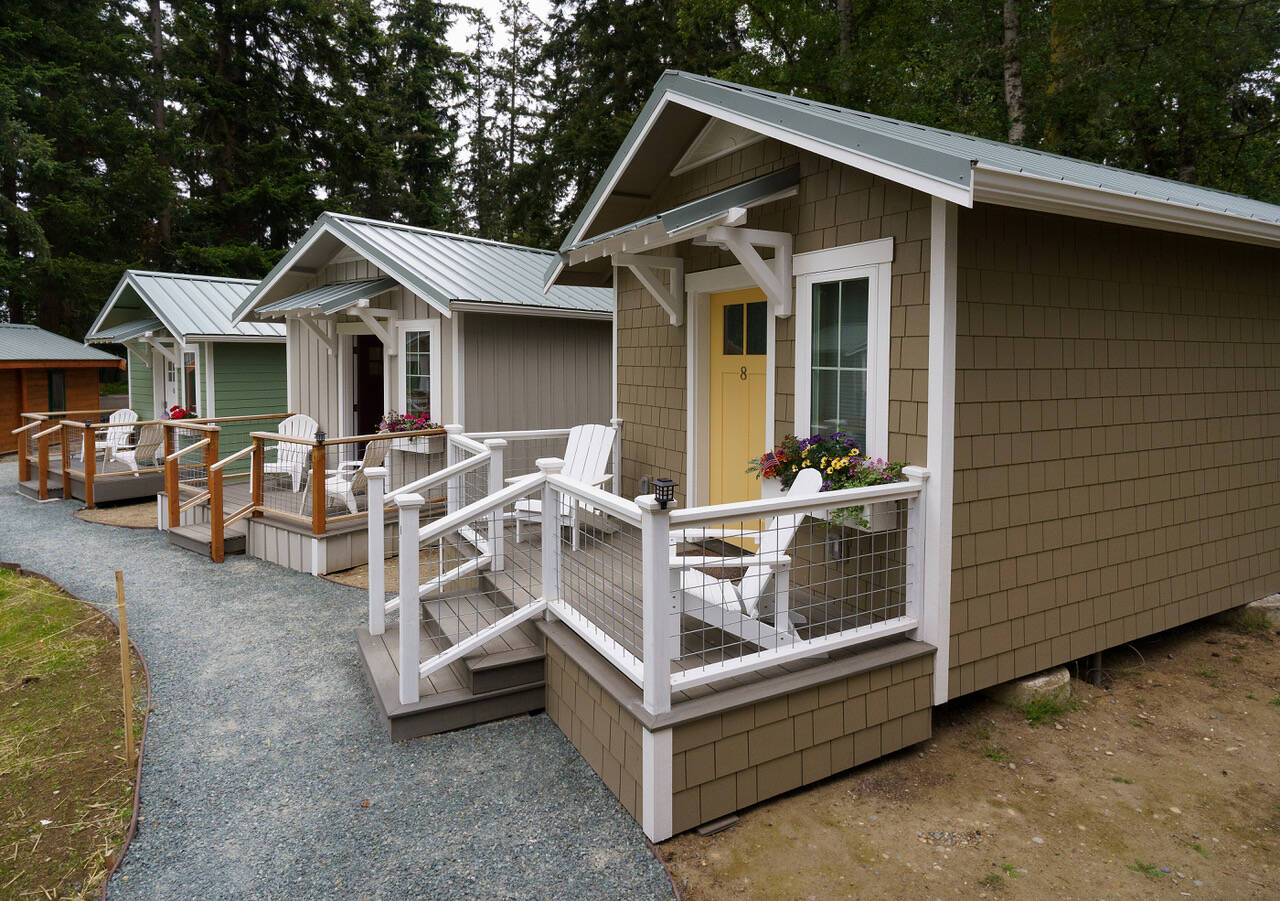By KATE POSS
Special to The Record
An idea for workforce housing has become reality with the completion of a project by Tiny Homes in the Name of Christ — or THiNC — in the city of Langley.
With nine 264-square-foot cottages circling a landscaped courtyard, the setting is welcoming and attractive. The homes, painted in palettes of blue, green or gray feature front porches and flower boxes under the windows. One house is covered in cedar panels. A tenth building, painted green, houses a pair of washer/dryers and a spare bathroom.
Spacious cottage windows let in light and views the courtyard. Kitchens feature stainless steel sinks, butcher block-topped roll-out islands, and tiled counters. A tiny living room gives views of the front porch. Generous-sized bathrooms and a small bedroom round out the comfortable and bright space.
The THiNC project, which is five years in the making, is the first tiny home village to be approved in Island County. The plan for each of the homes contains a bedroom, bathroom and a living room/kitchen. The cost for building each home was reduced to $34,000, thanks to volunteer help and discounts given on building materials.
Prior to the tiny homes being built, THiNC renovated a full-sized house on the property in 2017, in which a low-income family now lives. A resident caretaker lives downstairs.
While not oriented with any one faith, THiNC’s founders Coyla Shepard and Marilee Johnson worked with a number of churches, organizations, businesses and volunteers whose cumulative efforts have resulted in making a dent in providing workforce housing.
Now that THiNC will soon have people living in its cottages, Shepard is grateful for providence, which she says created solutions and provided a supply of volunteers. Shepard is a woman who motivates others to step up and lend a hand.
“The people of our local churches reached out to their friends and neighbors and brought them in as volunteers,” Shepard wrote in a recent text. “It became a real community outreach with both Christians and others working together.”
One of the volunteers is THiNC board member Deborah Hedlund, a retired judge for 33 years from Minnesota. Before that she served as a criminal law professor, prosecutor, public defender and city attorney of a small community and corporate counsel. She retired to Whidbey Island in 2013.
Hedlund has a commanding, no-nonsense presence.
“I worked as an advocate for homeless people when they needed representation,” Hedlund explained. “Coyla has a way of inviting people in so that they want to be part of what she is doing. I got roped into being on the (THiNC) board. Said I’d help for only two weeks, and now I’ve been with them four years. I fight with the city to make sure they’re following the law and moving THiNC forward.”
Hedlund helped secure a $70,000 completion bond at no cost by talking to a local bank which agreed to support THiNC.
Meredith Penny, Langley’s director of Community Planning, said all that’s needed prior to occupancy is a final engineer’s report from THiNC. That report is expected in a few days.
The residents started moving into their tiny new homes Friday. Residents for the village were selected and approved by THiNC’s board of directors. Rent is paid on a sliding scale based on income. Two of the future THiNC residents are currently living at the House of Hope, a transitional homeless shelter located in Langley. Another is an amputee with special challenges. A pair of mothers with children will move into two of the cottages.
Bon Thayer has served as THiNC’s site manager for the past two years and has helped coordinate construction of the homes. Associated with the Veterans’ Resource center across the street at the South Whidbey Community Center, he learned that THiNC wanted someone to help manage the project and offered to help.
“There was a lot of drawings and a lot of ideas,” Thayer said. “My father was a civil engineer and I was an engineering assistant. I got a chance to get things rolling. We’ve done a lot of work to get to where it is at now.”
Buying the property with donations, securing permitting from the city of Langley, grading the property, installing utilities, having high school wood shop students helping to install porticos over the front door, sourcing materials, landscaping, and finding financing and volunteers are among some of what it took to bring the project to completion.
“We have done a lot of documentation on the development of the project and are willing to share what we have with any other group that would like our assistance, and how we’ve managed to get this far,” Thayer said.
He estimates between 150 to 200 volunteers have helped THiNC become reality.
For more information, visit the THiNC website at thincwhidbey.com.



